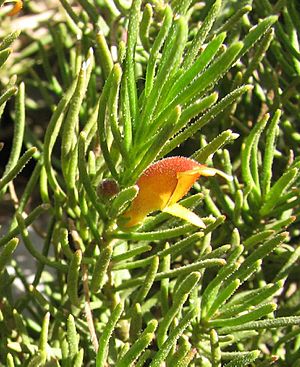Lake King eremophila facts for kids
Quick facts for kids Lake King eremophila |
|
|---|---|
 |
|
| Eremophila subteretifolia in Royal Botanic Gardens, Cranbourne | |
| Conservation status | |
| Scientific classification | |
| Genus: |
Eremophila (plant)
|
| Species: |
subteretifolia
|
The Eremophila subteretifolia, also known as the Lake King eremophila, is a special flowering plant. It belongs to the figwort family, called Scrophulariaceae. This plant is only found in Western Australia, which means it's endemic there.
It's a low-growing plant that spreads out along the ground, like a green carpet. It has thin, sticky, dark green leaves and bright orange-red or yellow flowers that really stand out! You can usually find this rare plant growing near the edges of salt lakes.
Contents
What Does It Look Like?
The Lake King eremophila is a low, spreading prostrate shrub that grows between 3 and 20 centimeters (about 1 to 8 inches) tall. Its branches feel rough because of old leaf bases. When they are young, the branches are a bit hairy, but they become smooth (or glabrous) as they get older. They are also sticky because of a natural sticky substance called resin.
Its leaves are packed closely together and overlap. They are thick but flat, shaped like a line, and usually 12 to 19 millimeters (about half an inch) long and only about 1 millimeter (a tiny bit) wide. Just like the branches, the leaves are sticky with resin. They start with a few hairs but become smooth over time and have tiny little pits on them.
The Flowers
The flowers grow one by one where the leaves meet the stem. They sit on sticky, hairy stalks that are 2 to 6 millimeters (about a quarter of an inch) long. Each flower has 5 narrow, sticky, triangle-shaped parts called sepals. These sepals are 2.5 to 6 millimeters long and are mostly covered with tiny, sticky hairs called glandular hairs.
The colorful parts of the flower, called petals, are 15 to 22 millimeters (about three-quarters of an inch) long. They join together at the bottom to form a tube. This petal tube is orange-red to yellow and is covered with glandular hairs both inside and out. There are 4 stamens (the parts that hold pollen) that stick out beyond the end of the petal tube. This plant usually blooms between November and March. After the flowers, it grows dry, pear-shaped fruits that are 3.5 to 5 millimeters long and have clear grooves.
How It Got Its Name
This plant was officially described for the first time in 2007 by a scientist named Robert Chinnock. He wrote about it in a book called Eremophila and Allied Genera: A Monograph of the Plant Family Myoporaceae.
The second part of its scientific name, subteretifolia, comes from Latin words. It means "subterete-leaved," which describes its narrow leaves.
Where Does It Live?
The Lake King eremophila likes to grow in sandy soil near the edges of lakes and in salty, flat areas. You can find it near Lake King and Ravensthorpe in Western Australia. These areas are part of special natural regions called the Esperance Plains and Mallee.
Protecting This Rare Plant
The Eremophila subteretifolia is considered a "Threatened Flora" by the Department of Environment and Conservation in Western Australia. This means it's a very rare plant that needs protection.
It is also listed as "Endangered" (EN) under an important Australian law called the Environment Protection and Biodiversity Conservation Act 1999. This means it's at high risk of disappearing forever. Because of this, a special plan has been made to help it recover.
In 2002, scientists estimated there were only about 119 adult plants left in the wild, spread across six different places south of Lake King. This plant faces several dangers:
- Increasing saltiness: The soil is becoming too salty.
- Waterlogging: Too much water can harm the roots.
- Road maintenance: Work on roads can damage its habitat.
- Vehicle damage: Cars and trucks can accidentally hurt the plants.
- Grazing by rabbits: Rabbits (Oryctolagus cuniculus) like to eat the plants.
Good for Gardens
This low-growing eremophila is great for using as a ground cover in gardens, or it can trail nicely over walls. When it blooms, it can create a beautiful display of orange-red flowers. It's also good at stopping weeds from growing.
It's quite easy to grow new plants from cuttings (small pieces of the plant). Once it's settled, it grows well in soil that drains easily, in a sunny or partly shaded spot. It can handle dry periods (it's drought tolerant), so it only needs water sometimes during a drought. Be careful not to give it too much water, as that can kill it! It can also handle cold weather (it's frost tolerant) and can be trimmed when needed.


